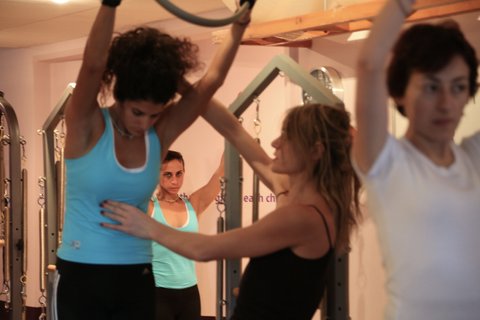
Tips From a Pilates Master Trainer
Over the years, I have been fortunate enough to teach hundreds of clients privately and in my group classes. My journey in teaching started in 2000 and I am to this day in awe of this incredible method, Pilates. I see clients transform not only in their bodies but their entire sense of self. A client recently sent me a message thanking me for feeling so connected to her body inside out, at the studio and in her daily life.
She feels longer, walks taller, has no more lower back pain and she can see abs for the first time ever after practicing for six months, once a week only!
Isn’t it wonderful to know that just by moving in specific ways and paying attention to how your body reacts, you will achieve optimal health?
Pilates helps you gain strength, tone your body, get rid of pain, improve your energy levels and mood. The more you practice, the more “ in control” and at ease you feel in your body.
Unfortunately, Pilates in the UK has been transformed into many different versions, which are sometimes not related to Pilates, but linked to exercise fads. It is a sad truth, which classically trained instructors like me, who believe in preserving the authenticity of the method, have to live with.
Here’s my advice to you when you want to start practicing Pilates:
- Look for a classically trained teacher. Someone who trained comprehensively with programmes founded by Pilates elders i.e. first generation teachers. I am, for example, a third-generation teacher of authentic Pilates, taught by Romana Kryzanowska. I trained with Brooke Siler in New York, who trained with Romana herself. I have also done many workshops throughout the years with Jay Grimes, another Pilates elder, Peter Fiasca and Kathy Ross-Nash. Just after Covid, I also joined and observed a classical teacher training program at PI studio in London. Practicing the method and working with other teachers never ends in the life of a classical Pilates teacher, it’s a lifetime commitment.
This is what you need to look for: authenticity, experience and a well-equipped studio
- Take a few private sessions before you join group classes. A good studio will allow participants to join group classes only after booking 5 to 10 private lessons. This will help you make the most of your practice; you will understand the apparatus and how to use them; you will be able to connect to your body and understand the verbal cues used by the instructor, as they are Pilates- specific cues, which help you deepen your body connections. It is the best investment you can gift yourself!
- A good Pilates studio will have all the apparatus which are: the universal reformer, Cadillac, Guillotine, wunda chair, high chair, ladder barrel, armchair, spine corrector, small barrel, Pedi- pole. There are props such as the foot corrector, airplane board, and toe stretcher, which should also be available
- Studios labelled as reformer Pilates, Hiit Pilates, Circuit Pilates, Boot Camp Pilates aren’t really Pilates. Such studios use the reformer for workouts which have nothing to do with the classical pilates order. If real pilates is what you are looking for, such studios aren’t the place to go to.
Private session costs vary at studios. A session with an apprentice can start at £80 depending on the studio; sessions with a master trainer can be £120 and more.
Master trainers can assess then refer clients to teachers at their studio who will best be suited to the client’s needs. The Master Trainer will focus on teacher training programmes and passing on the Pilates method which is unrivalled in creating a strong and agile body.
This is the stage that I am at in my career. My journey started with Pilates and I keep coming back to Pilates. There must be a reason for this or even a multitude of reasons!